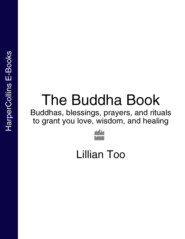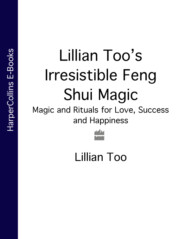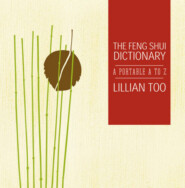По всем вопросам обращайтесь на: info@litportal.ru
(©) 2003-2024.
✖
Lillian Too’s Smart Feng Shui For The Home: 188 brilliant ways to work with what you’ve got
Автор
Год написания книги
2019
Настройки чтения
Размер шрифта
Высота строк
Поля
Lillian Too, Kuala Lumpur October 2000
1 smart feng shui basics (#ulink_e7f63452-43b6-54a8-b536-e4b3eeade45d)
1 – a feng shui view of the living space
As the world becomes increasingly familiarized with feng shui, this ancient Chinese practice brings ever-growing benefits to those who apply it in their homes.
Feng shui, which literally means wind and water, promises a way of arranging space so that it brings residents good fortune while simultaneously reducing misfortune. Feng shui has gained popularity because many people are discovering that it works, and that it does not have to be difficult to bring fast results. It is easy to use at different levels, and many people are now convinced that at least some working knowledge of feng shui is necessary when setting up home, buying a new home or simply assessing one’s existing living space. It is becoming so sought after that people are finding themselves wishing that they knew exactly how to get started without having to plough through reams of books and, more importantly, without getting confused by the proliferation of feng shui literature now available.
This book on easy and practical feng shui deals with feng shui that is within the control of the average person. Solutions to feng shui afflictions usually take account of practical considerations – after all, we must work with what we’ve got. So space limitations, general immovability of doors, the presence of overhead beams, of missing corners and so forth, which often represent afflictions one cannot do much about, have a lower priority here than those aspects of the practice that can be more easily applied, thereby enhancing your feng shui overall.
Start by understanding that there are four different aspects to the practice of feng shui: exterior feng shui, interior feng shui, the importance of orientations, and time dimension feng shui, which are dealt with separately in the next four Tips.
With your floor plan and the orientations of important rooms, you can improve your feng shui.
Note some impressions – look at the size, shape, and flow of chi, or energy, within the home.
Take the orientation of the main door and see if anything is hurting it.
Get yourself oriented correctly. Use a compass to mark out the different sectors.
Superimpose the directions onto a floor plan of your home, and note the compass sector of important rooms.
Feng shui at home begins with a floor plan.
2 – the first aspect: exterior feng shui
This is the feng shui of the outside environment that surrounds an office building or your home. Different factors are considered that can affect whether the site is considered auspicious.
Exterior feng shui involves assessing a landscape in order to study the effects of mountains, hills, rivers waterways, roads, shapes, and the configuration of contours.
The external view gives you a bigger picture of feng shui, but your surroundings are usually way outside the average person’s control. Even when you know how to detect good and bad landscape feng shui, you are seldom in a position to do much about it. In modern-day living, especially in towns and cities, the practice of landscape feng shui often presents insurmountable physical and budgetary constraints.
Old traditions
The Chinese believe that every site is surrounded by four protective animal spirits: the black tortoise, the phoenix, the green dragon, and the white tiger. When a site is being assessed, the four animal names may be applied to the four points of the compass – so that north is the black tortoise, south is the phoenix, east is the green dragon, and west is the white tiger. The superior dragon hill needs to be higher and more rugged than the tiger hill. The southern, phoenix aspect should be open.
The four celestial creatures of exterior feng shui are the black turtle behind a dwelling, the green dragon on the left, the white tiger to its right, and the red phoenix in front. Their symbolic presence brings good fortune.
The white tiger is the embodiment of yin energy. It complements the yang of the green dragon.
3 – the second aspect: interior feng shui
This is taking a detailed feng shui perspective of an interior setting, looking at the chi energy flow inside houses, apartments, and office buildings.
This deals with the layout of rooms, the flow of traffic, the arrangement of furniture, the selection of colors, shapes, dimensions, and decorative materials to ensure that auspicious chi gets created within homes, and inside the rooms of offices and apartments. Interior feng shui is usually well within the control of most people. From a practical perspective, this is the branch of feng shui practice that offers the most scope for individual solutions and creativity. Taking a feng shui view of the living space therefore is primarily about interior feng shui.
Rooms in the house
Interior feng shui involves looking at the position and orientation of the front door, how the chi energy flows in, and how it enters all the rooms in the house. Any obstructions, such as pillars, beams, or badly placed staircases, are neutralized with feng shui cures such as windchimes, crystals, and plants. It is learning to train your eye so that you can easily spot problems in each area or room of your home, knowing how to position your bed auspiciously, and hang mirrors to advantage.
In interior feng shui, the front door should open inwards. An auspicious painting in the hall, such as this fish, symbolizes wealth coming into the mouth of the home.
Check out the view from your front door. A curved path and healthy plants bring in good chi energy, while a straight path or telegraph poles will create negative chi for your home.
4 – the third aspect: the importance of orientations
In Chinese feng shui, all the compass orientations of a house, apartment, or office play the largest and most crucial role in correct feng shui practice.
It is vital to establish orientations correctly before powerfully potent feng shui formulas can be correctly activated to bring fast results. This requires the use of a reliable compass and some basic reference points with which to demarcate your living and work areas. This can collectively be called the space dimension of interior feng shui, and to a very large extent this too is within the control of most people. So when you want to feng shui any living space, one of the first things you absolutely must take account of is the relative orientation of rooms, of doors, and furniture placement.
Taking a feng shui view of any space should always include input on orientations.
Using a compass
As is mentioned later in the book, you need to use a good Western compass to find out the orientation of your home and all its rooms, so that you can apply some of the most potent feng shui formulas. You can find out the facing and sitting directions of your home (see here (#litres_trial_promo) and here (#litres_trial_promo),) and once the directions of each room have been established, you can activate the corners to your advantage. Even when you combine different feng shui formulas in your home, the compass directions are essential for accuracy of placing enhancements or cures, or as mentioned previously, to be aware of bad flying star configurations in different areas.
Using a compass to find the orientation of your living space, doors, windows, and furniture is the first step in understanding feng shui. If you can find the center point of your home, position a compass there and get the orientations of your living space from there.
5 – the fourth aspect: time dimension feng shui
Time dimension feng shui uses the powerful flying star formula, which refers to numbers of good luck and misfortune which affect and afflict the living space.
So after you have satisfactorily arranged the living space in accordance with all the rules and guidelines to create auspicious energy, it is then necessary to investigate how the luck of any living space can change merely by the passage of time. According to an important school of feng shui practice, every hour, day, month, and year exerts its special essence of invisible, intangible forces. These can bring extreme good fortune or intense misfortune depending on how the time stars affect different corners of your living space. Once again, this aspect of feng shui is well within one’s control. There are easy formulas, which I have condensed into tables (see Chapter 8 (#litres_trial_promo)) so that you will easily see what needs to be done at the start of each month or year in order to avoid misfortunes or to activate some good fortune. This branch of feng shui can often be predictive when you understand the basic formula of calculating the time dimension stars. Once you know the areas that are affected each year, you can apply a cure, if it is necessary, in the appropriate corner so that you will not be affected by the negative energy that will emanate from this space.
This is the annual flying star chart for 2002, the year of the Horse. Note that in this year the lucky sectors which are represented by the lucky numbers 8, 6, and I are the northwest, the southeast, and the northeast of the house space or any living space. The most auspicious corner of your rooms in 2002 is therefore the northwest. In that year the unlucky sectors are the north and south, which are both afflicted. North is the place of three killings, or three types of bad luck. South is the place of the illness star and east is the place of the deadly hue, yellow. From this chart you will know instantly which corners to activate and use and which corners to avoid.
6 – introducing the luo pan, or chinese compass
The compass is essential to practice feng shui correctly as orientation is the bedrock of all feng shui analyses and recommendations – the foundation of Chinese feng shui.
Other techniques that deal with enhancing your living space may not use the compass, but it is used by all Chinese feng shui masters in Hong Kong, Taiwan, China, Singapore, and Malaysia, and by those who have migrated to the West and continue to practice genuine Chinese feng shui. Their advice is based on how structures, doors, house locations, contours, and so forth interact with each other in relation to their compass orientation.
The directions indicated by a reliable compass show how chi flows within any environmental space. Every compass direction has a number of attributes that can be related to the physical structures that lie in those directions. This tells us about the quality of chi energy in those areas in terms of space and time.
So if you want to practice genuinely authentic feng shui I have to advise you to get to know and understand the compass. We can start with the Luo Pan, the traditional feng shui compass.
The Luo Pan compass is similar to any Western-style compass, in that it divides directions into 360 degrees around a circle. This is further divided into 8 main directions and 24 subdirections. These sub-directions are referred to as the 24 mountains, and each mountain measures 15 degrees (360 divided by 24 = 15.) The ring that indicates these 24 mountains is very important, simply because many feng shui formulas use the 24 mountain divisions to express good- and bad-luck orientations.
The three Luo Pans
The traditional Luo Pan is a highly revered work of great craftsmanship. It is always hand made, and its many concentric rings contain the secrets and the formulas of the master who designed it. There are several different types of Luo Pan, but the three most popular and frequently used today are:
1 The Sarn Yuan Luo Pan, which is based on the Three Cycles School. This is also referred to as the Three Period Flying Star Luo Pan.
2 The Sarn Harp Luo Pan, often referred to as the Three Harmony compass. This refers to the harmony between Heaven, Earth, and Man and is reflected in the Man Plate, the Earth Plate, and the Heaven Plate featured on this Luo Pan. These different plates are believed to reflect the three parallel levels of energy flow within the environment, and each takes the north as being 7.5 degrees different from the other. Thus the Earth Plate refers to the magnetic north but the Man and Heaven plates are 7.5 degrees to the left and right of the Earth Plate. So the north referred to in these other plates is not magnetic north.
3 The Sarn He’ Luo Pan, which is called the Three Auspicious Happenings School. This looks at the landforms, mountains, structures, and water that surround any building, and analyzes their good and bad influences based on period numbers, elements, and trigrams.










